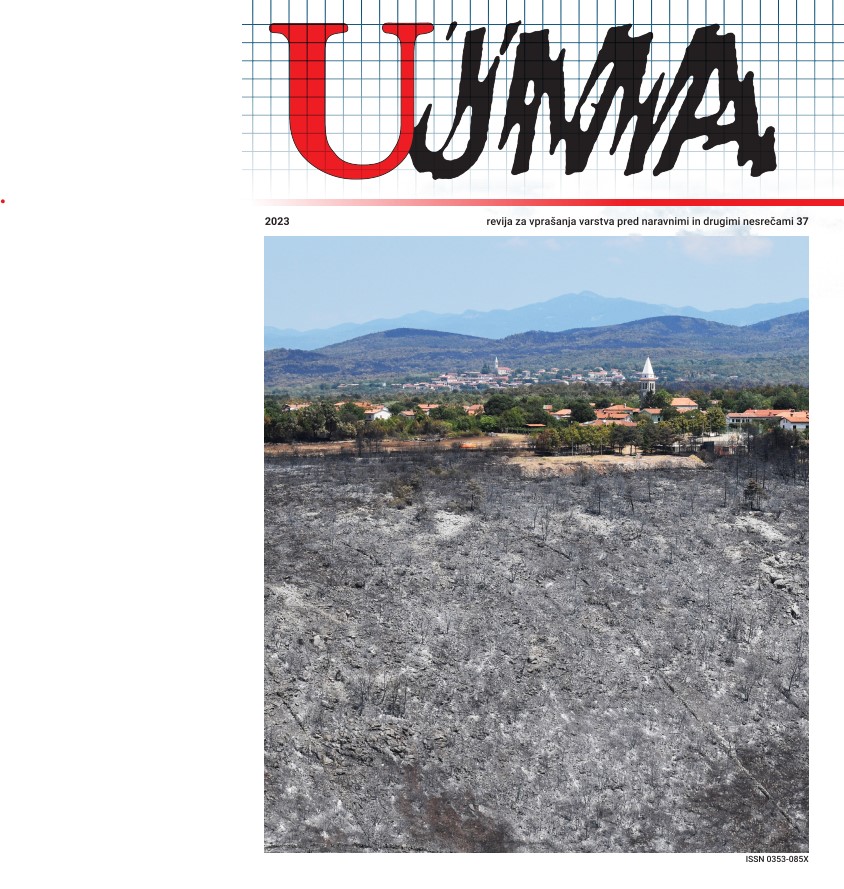ASSESSMENT OF PUBLIC HEALTH RISKS IN THE EVENT OF CHEMICAL ACCIDENTS
Abstract
Chemical accidents can endanger public health. The consequences for health can be direct or indirect, short-term or long-term, or delayed. In Slovenia, the system for responding to and managing emergencies is well-organized, but accidents in a broader sense are less effectively controlled. Although the impacts of an accident on public health and the environment may not be immediately apparent, the consequences can be long-lasting. The role of public health organizations is primarily to strengthen the resilience of society, and to implement protective measures to mitigate the harmful effect of such impacts. In the event of a chemical accident, particularly when exposure to hazardous substances is possible, a public health expert prepares a health risk assessment based on the available information, and proposes measures to limit that risk. Throughout the entire process, including data gathering, preparation of measures, and communication, collaboration with other stakeholders is crucial. Only through such collaboration can risk management be successful.
References
Jeraj, J., 2018. Zgodovinski razvoj teoretičnega modela celovitega spoprijemanja z nesrečami. Ujma, 32, 244–249.
Nacionalni inštitut za javno zdravje, 2017. Perharič, L., in Pollak, P., urednika. Navodila za izdelavo ocene tveganja za zdravje ljudi zaradi izpostavljenosti kemijskim in mikrobiološkim dejavnikom iz okolja z izbranimi poglavji in praktičnimi primeri; I. del. https://nijz. si/publikacije/navodila-za-izdelavo-ocene-tveganja-za-zdravje-ljudi-zaradi-izpostavljenosti-kemijskim-in-mikrobioloskim-dejavnikom-iz-okolja-z-izbranimi-poglavji-in-prakticnimi-primeri-i-del/, 18. 5. 2023.
Public Health England, 2018. Gent, N., Milton, R., editors. CRBN incidents: Chemical, biological, radiological and nuclear incidents: clinical management and health protection. 2nd ed. https://assets.publishing.service.gov.uk/government/uploads/system/uploads/attachment_data/file/712888/Chemical_biological_radiological_and_nuclear_incidents_clinical_management_and_health_protection.pdf, 10. 5. 2023.
World Health Organization, 2009. Manual for the public health management of chemical incidents. https://apps.who.int/iris/rest/bitstreams/52481/retrieve, 16. 4. 2023.
World Health Organization , 2016. International Health Regulations (2005), 3rd ed. https://apps.who.int/iris/rest/bitstreams/1031116/retrieve, 18. 4. 2023.
World Health Organization, 2017. Communicating risk in public health emergencies: a WHO guideline for emergency risk communication (ERC) policy and practice. https://apps.who.int/iris/bitstream/handle/10665/259807/9789241550208-eng. pdf?sequence=2&isAllowed=y, 16. 5. 2023.
World Health Organization, 2019. Health Emergency and Disaster Risk Management Framework. https://apps.who.int/iris/bitstream/handle/10665/326106/9789241516181-eng.pdf?sequence=1&isAllowed=y, 16. 5. 2023.
World Health Organization, 2021. WHO human health risk assessment toolkit: chemical hazards, 2nd ed. (IPCS harmonization project document, no. 8). https://apps.who.int/iris/rest/bitstreams/1398803/retrieve, 11. 4. 2023.
World Health Organization, 2023a. Chemical incidents. https://www.who.int/health-topics/chemical-incidents#tab=tab_1, 26. 4. 2023.
World Health Organization, 2023b. Risk management. https://www.who.int/activities/implementing-health-emergency-and-disaster-risk-management, 16. 5. 2023.
Zakon o zdravstveni dejavnosti. Uradni list RS, št. 23/05, 15/08 –ZPacP, 23/08, 58/08 –ZZdrS-E, 77/08 – ZDZdr, 40/12 –ZUJF, 14/13, 88/16 – ZdZPZD, 64/17, 1/19 – odl. US, 73/19, 82/20, 152/20 – ZZUOOP, 203/20 – ZIUPOPDVE, 112/21 – ZNUPZ, 196/21 – ZDOsk, 100/22 – ZNUZSZS, 132/22 – odl. US, 141/22 – ZNUNBZ in 14/23 – odl. US.
Downloads
Published
Issue
Section
License

This work is licensed under a Creative Commons Attribution-NonCommercial-NoDerivatives 4.0 International License.
The articles are made available to the public under Creative Commons Attribution-NonCommercial-NoDerivatives 4.0 International (CC BY-NC-ND 4.0).


